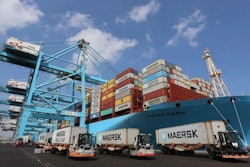
In times of global crisis, the world relies on the trucking industry to transport essential items across the country. From medical supplies to restocking the shelves at local grocery stores, truck drivers play an integral role in maintaining the supply chain. In order to keep these essential items moving during the Coronavirus disease (COVID-19) crisis, the Department of Transportation has suspended most of the Hours of Service regulations for those trucks transporting these essential goods.
Commercial truck drivers have had their driving hours extended from 11 to 14 hours depending on the goods being carried. With so much going on and so many depending on trucking and freight transportation organizations, fleet managers and owners need to be extremely organized to handle current and future industry needs. With that in mind, here are some ways in which companies can keep track of their fleet during a time of heightened demand and uncertainty:
Communication is key
The visibility that essential telematics technology brings can be incredibly helpful. Being able to stay in constant communication with drivers via messaging and dedicated contact forms—as well as knowing their locations at all times—allows fleet managers to make informed decisions. With things being so hectic right now, knowing where your assets are, who is available for the next load, who is nearest to the depots and who has encountered longer detention times is critical in a time when efficiently maintaining the fleet on the road is more important than ever.
Most likely due to shelter-in-place orders reducing the traffic overall, many of the states experiencing the highest level of COVID-19 spread are seeing a reduction in travel times for drivers. According to the American Transportation Research Institute (ATRI), freight trucks are clocking faster times overall in these areas, particularly in regularly congested areas. That being said, because of additional route changes, border regulations and detention delays, freight is taking longer to transport. Having access to accurate telematics and open lines of communication with drivers will be key in planning and tracking routes.
Documentation should continue
While logs are not mandatory to be kept while under the Federal Emergency Declaration, continuing to make notes and annotate the daily log with the reason for non-compliance is a good practice. This will make sure that logs are current when the emergency declaration is lifted. It’s a good idea to integrate a route planner or add-on the service if it isn’t included by your telematics provider to facilitate the planning of loads and tasks. With so much on the fleet manager’s plate and the additional hours drivers are logging, any opportunity for automation should be embraced.
Driver safety
For all fleet managers, the safety of your drivers should be the top priority. The Department of Transportation Hours of Service regulations are there for a reason. The guidelines, of course, are there to make sure that drivers are not being overtaxed, reducing the possibility of accidents. Giving your team ample time to rest before taking the next load is imperative. And, while its required that drivers receive at least 10 consecutive hours off if they let their company know they need immediate rest, they may be inclined to push themselves given the current situation, feeling a responsibility to their fleet manager and the community at large. Plus, with people practicing social distancing, it’s likely there will be an uptick in e-commerce purchases, adding additional strain to fleet capacity. A fleet tracking tool will allow managers to review driver’s time, how often they have completed a 14-hour shift and allow for properly scheduled rest periods to avoid exhaustion and potential accidents.
Track maintenance
While drivers are putting in the extra miles, so are their rigs. Keeping track of oil changes, tire rotation and other regular maintenance items can keep drivers and trucks safely on the road. While you may think a global crisis is not the time to stop for regular maintenance, these quick care items are much easier and more cost effective to complete than larger complications they could cause going unaddressed. An oil change can help engines run more efficiently and reduce a fleet’s cost per mile. Taking time to examine tires could reveal a small leak or puncture which could lead to a popped tire on the road, leaving your driver stuck for hours on end or even cause them to lose control of the truck due to the blowout. Addressing these regular maintenance items will boost efficiency and save time in the long run.
Invest in add-ons
During times of global crisis, the supply chain can change at a moment’s notice. Add-ons such as a brokerage provider integration can help keep the lines of communication open with your customers and help you keep track of where the loads are and when they will arrive. With demand high, and lives on the line while carrying freight like medical supplies, these up-to-the-moment notices can be key in providing your team and customers with the proper support.
Driving demand
There’s no doubt about it¾the trucking industry is a key player in combating this global crisis. Delivering everything from medical supplies, to food to other e-commerce purchases for those in quarantine, the country is demanding quite a bit from our fleets. By staying organized and using helpful telematics tools, fleet managers and owners will be able to meet this challenge with the knowledge they need to make smart decisions. Staying in constant communication with drivers and customers will also help manage expectations and make sure everyone is on the same page.


















